
| ||||
|---|---|---|---|---|
 |
 |
 |
 |
 |



























| ||||
|---|---|---|---|---|
 |
 |
 |
 |
 |


























North American SNJ-5 Texan (NA-88)
WWII single-engine two-seat low-wing advanced trainer monoplane
.png)
Archive Photos
1941 North American SNJ-5 Texan (NA-88, BuNo 43683, c/n 88-15348, N2550) on display (11/10/2007) at the 2007 Aviation Nation Airshow, Nellis AFB, Las Vegas, Nevada (Photos by John Shupek)
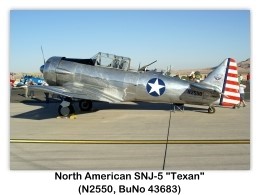
1941 North American SNJ-5 Texan (NA-88, BuNo 43763, c/n 88-15754, N7300C/6-49) on display (8/27/2005) at the 2005 Camarillo Air Show, Camarillo, CA (Photos by John Shupek)
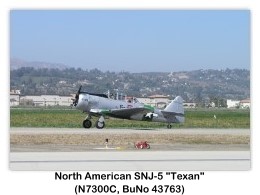
1941 North American SNJ-5 Texan (NA-88, BuNo 43763, c/n 88-15754, N7300C/6-49) on display (1/11/2009) at the 2009 Cable Air Show, Cable Airport, Upland, CA (Photos by John Shupek)














North American SNJ-5 Texan (NA-88, BuNo 43928, c/n 88-16210, N817NP/NP 2) on display (6/20/1999) at the 1999 Camarillo Air Show, Camarillo, CA (Photos by John Shupek)


1946 North American SNJ-5 Texan (NA-88, BuNo 84827, c/n 88-16498, N7979C) on display (4/4/2002) at the Pearson Air Museum, Vancouver, Washington (Photos by John Shupek)
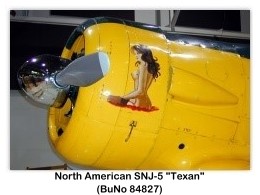
1942 North American SNJ-5 Texan (BuNo 84844, s/n 88-16574, N3680F/P HL) on display (6/20/1999) at the 1999 Camarillo Airshow, Camarillo, CA (Photos by John Shupek)
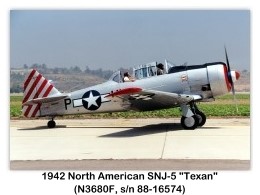


1942 North American SNJ-5 Texan (NA-88, BuNo 90680, c/n 88-17678, ex AF 42-85897, was N6972C/72, now N654DS) on display (8/1/1995) at the Hawthorne Air Faire, Hawthorne, CA (Photos by John Shupek)

1943 North American SNJ-5 Texan (NA-88, BuNo 84865, c/n 88-16676, N89014/SB290) on display (8/27/2005) at the 2005 Camarillo Air Show, Camarillo, CA (Photos by John Shupek)




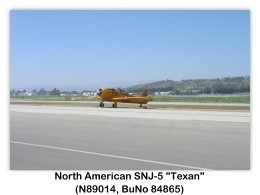
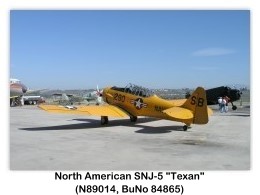
North American SNJ-5 "Texan" (N24554, BuNo 27753, NA-88) on display at the Hawthorne Air faire, Hawthorne, CA

North American SNJ-5 "Texan" (N1038A, BuNo 90917, NA-88) on display at the 2000 Torrance Airshow, Zamperini Field, Torrance, California
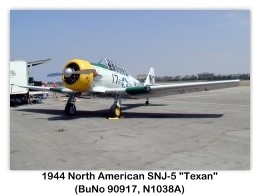

North American SNJ-5 "Texan" (N3375G, BuNo 90790, NA-88)On Display 8/27/2003 at the Planes of Fame Air Museum, Chino, California



North American SNJ-5 "Texan" (BuNo 91091, NA-88)on display 11/21/2004 at the USS Midway Aircraft Carrier Museum, San Diego, California
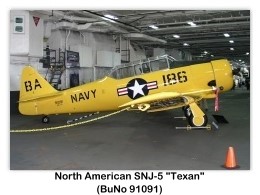
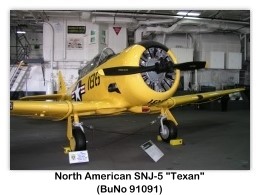
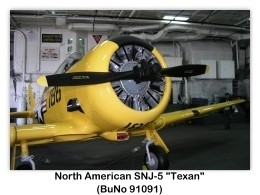
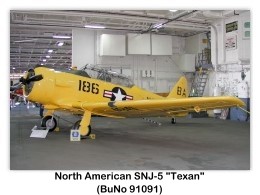
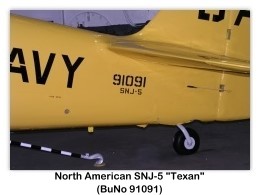
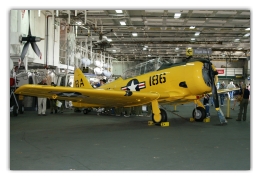
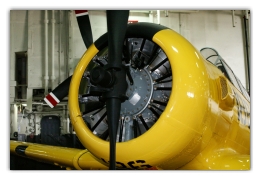

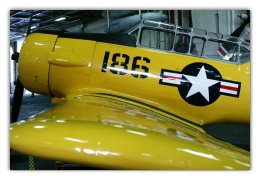

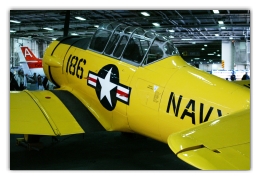
North American SNJ-5 "Texan" (N7300C, BuNo 43763N, NA-88)on display 8/27/2005 at the 2005 Camarillo Airshow, Camarillo, California

North American SNJ-5 "Texan" (N133SU, BuNo 91005, NA-88)on display 9/29/2003 at the Kalamazoo Aviation History Museum, Portage, Michigan

Overview
The North American Aviation T-6 Texan was a single-engine advanced trainer aircraft used to train pilots of the United States Army Air Forces, United States Navy, Royal Air Force and other air forces of the British Commonwealth during World War II and into the 1950s. Designed by North American Aviation, the T-6 is known by a variety of designations depending on the model and operating air force. The USAAC and USAAF designated it as the AT-6, the United States Navy the SNJ, and British Commonwealth air forces, the Harvard, the name it is best known by outside of the US. After 1962, US forces designated it the T-6. It remains a popular warbird aircraft used for airshow demonstrations and static displays.
Development
The Texan originated from the North American NA-16 prototype (first flown on April 1, 1935) which, modified as the NA-26, was submitted as an entry for a USAAC Basic Combat aircraft competition in March, 1937. The first model went in to production and 180 were supplied to the USAAC as the BC-1 and 400 to the RAF as the Harvard I. The US Navy received 16 modified aircraft, designated the SNJ-1, and a further 61 as the SNJ-2 with a different engine.
The BC-1 was the production version of the NA-26 prototype, with retractable tailwheel landing gear and the provision for armament, a two-way radio, and the 550 hp (410 kW) R-1340-47 engine as standard equipment. Production versions included the BC-1 (Model NA-36) with only minor modifications (177 built), of which 30 were modified as BC-1I instrument trainers; the BC-1A (NA-55) with airframe revisions (92 built); and a single BC-1B with a modified wing center-section.
Three BC-2 aircraft were built before the shift to the advanced trainer designation, AT-6, which was equivalent to the BC-1A. The differences between the AT-6 and the BC-1 were new outer wing panels with a swept forward trailing edge, squared-off wingtips and a triangular rudder, producing the definitive Texan appearance. After a change to the rear of the canopy, the AT-6 was designated the Harvard II for RAF/RCAF orders and 1,173 were supplied by purchase or Lend Lease, mostly operating in Canada as part of the British Commonwealth Air Training Plan.
Next came the AT-6A which was based on the NA-77 design and was powered by the Pratt & Whitney R-1340-49 Wasp radial engine. The USAAF received 1,549 and the US Navy 270 (as the SNJ-3). The AT-6B was built for gunnery training and could mount a 30-cal machine gun on the forward fuselage. It used the R-1340-AN-1 engine, which was to become the standard for the remaining T-6 production. Canada’s Noorduyn Aviation built an R-1340-AN-1-powered version of the AT-6A, which was supplied to the USAAF as the AT-16 (1,500 aircraft) and the RAF/RCAF as the Harvard IIB (2,485 aircraft), some of which also served with the Fleet Air Arm and Royal Canadian Navy.
In late 1937 Mitsubushi purchased two NA-16’s as technology demonstrators and possibly a licence to build more. However, the aircraft developed by Watanabe/Kyushu as the K10W1 (Allied code name *ldquo;Oak) bore no more than a superficial resemblance to the North American design. It featured a full monocoque fuselage as opposed to the steel tube fuselage of the T-6 and NA-16 family of aircraft, as well as being of smaller dimensions overall and had no design details in common with the T-6. It was used in very small numbers by the Imperial Japanese Navy from 1942 onwards. After the war the Japanese Air Self Defense Force operated Texans.
The NA-88 design resulted in 2,970 AT-6C Texans and 2,400 as the SNJ-4. The RAF received 726 of the AT-6C as the Harvard IIA. Modifications to the electrical system produced the AT-6D (3,713 produced) and SNJ-5 (1,357 produced). The AT-6D, redesignated the Harvard III, was supplied to the RAF (351 aircraft) and Fleet Air Arm (564 aircraft). The AT-6G (SNJ-5) involved major advancements including a full-time hydraulic system and a steerable tailwheel and persisted into the 1950s as the USAF advanced trainer.
Subsequently the NA-121 design with a completely clear rearmost section on the canopy, gave rise to 25 AT-6F Texans for the USAAF and 931 as the SNJ-6 for the US Navy. The ultimate version, the Harvard 4, was produced by Canada Car and Foundry during the 1950s, and supplied to the RCAF, USAF and Bundeswehr.
A total of 15,495 T-6s of all variants were built.
Combat Use
During the Korean War and, to a lesser extent, the Vietnam War, T-6s were pressed into service as forward air control aircraft. These aircraft were designated T-6 Mosquitos.
No. 1340 Flight RAF used the Harvard in Kenya against the Mau Mau in the 1950s, where they operated with 20-lb bombs and machine guns against the gangs. Some operations took place at altitudes around 20,000 ft above mean sea level. A Harvard was the longest-serving RAF aeroplane, with an example, taken on strength in 1945, still serving in the 1990s (as a chase plane for helicopter test flights, role for which the Shorts Tucano’s high stall speed was ill-suited).
The T-6G was also used in a light attack or counter insurgency role by France during the Algerian war in special Escadrilles d’Aviation Légère d’Appui (EALA), armed with machine guns, bombs and rockets. At its peak, there were 38 EALAs active. The largest unit was the Groupe d’Aviation Légère d’Appui 72, which consisted of up to 21 EALAs.
From 1961 to 1975, Portugal, also, used hundreds of T-6G in the counter insurgency role during the Portuguese Colonial War. During this war, almost all the Portuguese Air Force bases and air fields in Angola, Mozambique and Portuguese Guinea had a detachment of T-6Gs.
In 1957-58, the Spanish Air Force used T-6s as counterinsurgency aircraft in the Ifni War, armed with machine guns, iron bombs and rockets, achieving an excellent reputation due to its reliability, safety record and resistance to damage.
The Pakistan Air Force used T-6Gs in the 1971 war as a night ground support aircraft hitting enemy soft transport vehicles. In the early hours of 5 December, during a convoy interdiction mission in the same area, Squadron Leader Israr Quresh’s T-6G Harvard was hit by enemy ground fire and a shell fractured the pilot’s right arm. Profusely bleeding, the pilot flew the aircraft Back with his left hand and landed safely. The World War II vintage prop-engine trainers were pressed into service and performed satisfactorily in the assigned role of enemy convoys at night.
Mainly as a result of the United Nations arms embargo against South Africa’s Apartheid policies, T-6s remained in service with the South African Air Force as a basic trainer until 1995. They were replaced by Pilatus PC-7 Mk.II turboprop trainers.
In Popular Culture
After WWII, the National Air Races established a unique racing class for the AT-6/Texan/Harvard aircraft; This class continues today at the Reno National Air Races each year.
Since the Second World War, the T-6 has been a regular participant at air shows, and was used in many movies. For example, in Tora! Tora! Tora! and The Final Countdown, converted single-seat T-6s painted in Japanese markings represent Mitsubishi Zeroes, whereas in A Bridge too Far it represented the razorBack Republic P-47 Thunderbolt. The T-6 also appeared in the Pat Benatar video for Shadows of the Night. The New Zealand Warbirds Roaring 40s aerobatic team use ex-Royal New Zealand Air Force Harvard’s.
Recent Research Testbed
The Harvard 4 has also been recently used in Canada as a testbed aircraft for evaluating cockpit attitude displays. Its aerobatic capability permits the instructor pilot to maneuver the ship into unusual attitudes, then turn the craft over to an evaluator pilot in the blind rear cockpit to recover, based on one of several digitally-generated attitude displays.
Variants
North American BC Series
North American AT-6 Texan Series:
Noorduyn AT-16 Harvard Series:
T-6 Texan Series
SNJ Texan Series
Harvard Series
A-27
North American Aviation Company Designations
| NAA Charge No. | NAA Model or Designation | Customer | Engine Installed | Number | Notes |
|---|---|---|---|---|---|
| NA-16 | NA-16 | USAAC | Wright R-975-E3 Whirlwind (420-hp) | 1 | Prototype NX-2080, was open cockpit, received greenhouse canopy for trials |
| NA-18 | NA-18 | USAAC (trials) | Wright R-975-E3 Whirlwind (420-hp) | 1 (modified) | Ex-NA-16, won against Seversky BT-8 and Curtiss-Wright CW-19R, to Argentina in 1937 |
| NA-19 | NA-19, BT-9 | USAAC | Wright R-975-7 Whirlwind (400-hp) | 42 | Minor changes from NA-18, new canopy |
| NA-19A | NA-19A, BT-9A | USAAC | Wright R-975-7 Whirlwind (400-hp) | 40 | Armed BT-9 with one cowl gun and one rear flexible gun, and suitably modified canopy. |
| NA-20 | NA-16-2H | Trials, to Honduras (FAH) | Wright R-975 Whirlwind (Unknown sub-type) | 1 | NC16025 originally intended as demonstrator for China |
| NA-22 | NA-22 | USAAC (rejected) | Wright R-760ET (J-6-7) (225-hp) | 1 | Dangerously underpowered |
| NA-23 | NA-23, BT-9B | USAAC | Wright R-975-7 Whirlwind (400-hp) | 117 | Unarmed. 1 modified as sole BT-9D as BT-14 prototype with new outer wings and other alterations. |
| NA-26 | BC-1 | Trials, to Canada (RCAF) | P&W R-1340-S3H1 Wasp (550-hp) | 1 | Basic Combat Demonstrator NX18990 - no relation to later BC-1, first retractable gear variant, later modified with Yale parts. |
| NA-27 | NA-16-2H | To Fokker and Royal Netherlands AF | P&W R-1340-S2H1 Wasp (500-hp) | 1 | European demonstrator armed NA-26 with fixed gear. |
| NA-28 | NJ-1 | USN | P&W R-1340-6 Wasp (550-hp) | 40 | USN specification up engine BT-9 as advanced trainer, some re-engine with later R-1340 versions. |
| NA-29 | BT-9C | USAAC | Wright R-975-7 Whirlwind (400-hp) | 67 | as per BT-9A with minor changes. First aircraft completed as Y1BT-10. |
| NA-30 | BT-10 | USAAC (canceled) | P&W R-1340-41 Wasp (600-hp) | 0 | canceled production version of Y1BT-10 |
| NA-31 | NA-16-4M, Sk-14, Sk-14A | Sweden (Flygvapnet) | Wright R-975-E3 Whirlwind (420-hp) Piaggio P VIIc (525-hp) | 137 | BT-9C but different engine variant. Licence production (NAA built 1, ASJA 76, SAAB 60), Trialled undercarriage for Saab 21. |
| NA-32 | NA-16-1A | Australia (RAAF) | P&W R-1340 Wasp | 1 | Fixed gear pattern aircraft similar to NJ-1 or Y1BT-10, not followed up. |
| NA-33 | NA-16-2K, Wirraway | Australia (RAAF) | P&W R-1340-S1H1G (600-hp) | 756 | Retractable gear pattern aircraft for Australia, 1 built by NAA and 755 by Commonwealth Aircraft Corporation) |
| NA-34 | NA-16-4P | Argentina (FAA) | Wright R-975-E3 Whirlwind (420-hp) | 29 | First major export order (not licence), had 2 cowl guns, a flexible rear gun and a radio mast |
| NA-36 | BC-1 | USAAC | P&W R-1340-47 Wasp (500-hp) | 177 | Retractable undercarriage and first aircraft with square bottom rudder. Large DF loop between undercarriage, blister covering fuel transfer gear along centerline aft of wheel wells. |
| NA-37 | NA-16-4R, KXA1 | Japan (IJN) (Evaluation) | P&W R-985-9CG Wasp Junior (500-hp) | 1 | Technology demonstrator, unarmed, fixed landing gear and three bladed prop. |
| NA-38 | NA-16-4M | Sweden (Flygvapnet) | Wright R-975-E3 Whirlwind (420-hp) | 1 | same as NA-31 |
| NA-41 | NA-16-4 | China (ROCAF) | Wright R-975 Whirlwind | 35 | Similar to BT-9C with short fabric covered fuselage, combat aircraft with two fixed forward guns and one flexible rear gun. |
| NA-42 | NA-16-2A | Honduras (FAH) | P&W R-1340 Wasp (520-hp) | 2 | |
| NA-43 | NA-16-1G | Brazil (Army) (canceled) | Wright R-975 Whirlwind | 0 | Similar to BT-9C |
| NA-44 | NA-44 | to Canada (RCAF) | Wright SG-1820-F52 Cyclone (750-hp) | 1 | Prototype two-seat export combat aircraft similar to BC-1A |
| NA-45 | NA-16-1GV | Venezuela (FAV) | P&W R-1340 Wasp | 3 | Possibly originally built to Brazilian contract |
| NA-46 | NA-16-4 | Brazil (Navy) | Wright R-975-53 Whirlwind(400-hp) | 12 | Similar to BT-9C with wingtip slats, small DF loop under fuselage. |
| NA-47 | NA-16-4RW, KXA-2 | Japan (IJN) (Evaluation) | Wright R-975-E3 Whirlwind (420-hp) | 1 | Technology demonstrator |
| NA-48 | NA-16-3C | China (ROCAF) | P&W R-1340 Wasp | 15 | Similar to NA-45 |
| NA-49 | NA-16-1E, Harvard I | United Kingdom (RAF) | P&W R-1340-S3H1 Wasp (600-hp) | 400 | Straight wing trailing edge, square rudder, short fabric covered fuselage, fixed rear canopy, no blister under wing center section |
| NA-50 | NA-50 | Peru (FAP) | Wright R-1820-G3 Cyclone | 7 | Single seat fighter, NA-16-5 |
| NA-52 | SNJ-1 | USN | P&W R-1340-6 Wasp(500-hp) | 16 | Short metal fuselage, square rudder, late wings, fixed rear on canopy |
| NA-54 | BC-2 | USAAC | P&W R-1340-45 Wasp (600-hp) | 3 | Based on NA-36 with some improvements from NA-44, 3 bladed prop and two blister under wing center section. |
| NA-55-1 | BC-1A | USAAC | P&W R-1340-47/-49 Wasp (600-hp) | 83 | Bought for reserve and Air National Guard units. |
| NA-56 | NA-16-4 | China (ROCAF) | P&W R-1340 Wasp | 50 | Similar to NA-55 (long metal fuselage, fixed gear and engine differences) |
| NA-57 | NA-57, NAA 57 P-2 | France (Armée de l’Air) | Wright R-975-E3 Whirlwind (420-hp) | 230 | Improved NA-23, many captured and used by Germany, some retained by Vichy France |
| NA-58 | BT-14, BT-14A | USAAC | P&W R-985-25 Wasp Junior | 251 | Similar to Harvard II except for fixed undercarriage and smaller engine. 27 re-engine with 400-hp (298-kW) P&W R-985-11 as BT-14A |
| NA-59 | AT-6-NA | USAAC | P&W R-1340-47 Wasp (600-hp) | 94 | First examples converted from NA-55 while still on production line, some examples had small DF loop installed |
| NA-61 | NA-16-1E, Harvard I | Canada (RCAF) | P&W R-1340-S3H1 Wasp (600-hp) | 30 | Later fitted with extended exhaust for cabin heater |
| NA-64 | NA-64, NAA 64-P2/Yale I | France (Armée de l’Air) | Wright R-975-E3 Whirlwind (420-hp) | 230 | 119 to Canada (RCAF) as Yale I, briefly used by France, many captured by Germany |
| NA-65 | SNJ-2 | USN | P&W R-1340-36 Wasp | 36 | Blister covering fuel transfer gear along centerline aft of wheel wells |
| NA-66 | Harvard II | United Kingdom (RAF) | P&W R-1340 Wasp | 600 | as per NA-59 but fixed rear canopy and no rear gun, also to RNZAF and RCAF, Southern Rhodesia |
| NA-68 | NA-50A, P-64 | Thailand (RTAF) | Wright R-1820-77 Cyclone (870-hp) | 6 | Short outer wing panel angled much further forward than earlier types. Diverted with start of Pacific war to USAAF as P-64 |
| NA-69 | NA-44, A-27 | Thailand (RTAF) | Wright R-1820-75 Cyclone (745-hp) | 10 | Fully armed as attack aircraft. Diverted with start of Pacific war to USAAF as A-27 |
| NA-71 | NA-16-3 | Venezuela (FAV) | P&W R-1340-S3H1 Wasp (550-hp) | 3 | Two nose guns and rear gun, no wing guns. |
| NA-72 | NA-44 | Brazil (Army) | P&W R-1340-AN1/S1H1 Wasp (600-hp) | 30 | Attack bomber, fitted with small DF loop under fuselage. |
| NA-74 | NA-44 | Chile (FACh) | P&W R-1340 Wasp | 12 | Attack bomber, fitted with small DF loop under fuselage. |
| NA-75 | Harvard II | Canada (RCAF) | P&W R-1340 Wasp | 100 | Follow on order to NA-66 |
| NA-76 | Harvard II | United Kingdom (RAF) | P&W R-1340 Wasp | 450 | Originally ordered by France, taken over by RAF, many to RCAF |
| NA-77 | AT-6A, SNJ-3 | USAAC, USN | P&W R-1340 Wasp | 637 | same as NA-66 |
| NA-78 | AT-6A, SNJ-3/3C | USAAC, USN | P&W R-1340 Wasp | 568 | As NA-77, first aircraft built in Texas, and to use name Texan |
| NA-79 | SNJ-2 | USN | P&W R-1340-56 Wasp | 25 | |
| NA-81 | Harvard II | United Kingdom (RAF) | P&W R-1340 Wasp | 125 | same as previous RAF Harvard II order. |
| NA-84 | AT-6B | USAAC | P&W R-1340-AN-1 Wasp (600-hp) | 400 | |
| NA-85 | SNJ-3 | USN | P&W R-1340 Wasp | 0 | canceled duplicate of NA-78 for record purposes. |
| NA-88 | AT-6C, AT-6D, XAT-6E, SNJ-4, SNJ-5 | USAAC/USAAF, USN | P&W R-1340 Wasp/Ranger V-770 | 9,331 | (last 800 as NA-121) AT-6D used 24 volt electrics, vs previous 12 volt systems. XAT-6E used Ranger V-770. |
| NA-119 | AT-6D | Brazil (FAB) | P&W R-1340 Wasp | 81 | 20 examples built in Brazil under licence |
| NA-121 | AT-6D, AT-6F | USAAF, USN | P&W R-1340 Wasp | 4,378 | 800 AT-6Ds, 211 SNJ-5, 956 AT-6F and 411 SNJ-6. AT-6F and SNJ-6 have clear fixed rear canopy section |
| NA-128 | AT-6D | USAAF, USN | P&W R-1340 Wasp | 0 | Canceled orders to have been built in Texas. |
| NA-168 | T-6G, LT-6G | USAF/US ANG | P&W R-1340 Wasp | 109 | Re-manufactured and updated from earlier versions. Mostly internal but canopy simplified slightly. |
| NA-182 | T-6G, LT-6G | USAF/US ANG | P&W R-1340 Wasp | 824 | as per NA-168, Re-manufactured/updated. |
| NA-186 | Harvard IV | Canada (RCAF)/US MDAP | P&W R-1340 Wasp | 555 | Design Data for Canadian Car and Foundry possibly to build Harvard IV or T-6G, sole new post war production. |
| NA-188 | T-6G, LT-6G | USAF/US ANG | P&W R-1340 Wasp | 107 | Re-manufactured and converted from earlier versions. |
| NA-195 | T-6G, LT-6G | USAF/US ANG | P&W R-1340 Wasp | 11 | Re-manufactured and converted from earlier versions. |
| NA-197 | T-6G | USAF/US ANG | P&W R-1340 Wasp | 110 | Re-manufactured and converted from T-6D. |
| SNJ-8 | USN | P&W R-1340 Wasp | 0 | canceled Contract for SNJ-8 (similar to T-6G) |
Operators
Specifications SNJ-5 (NA-88)
Type
Wings
Fuselage
Tail Unit
Landing Gear
Power Plant
Accommodation
Systems
Armament
Dimensions
Weights and Loadings
Performance
References